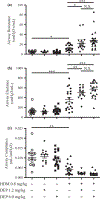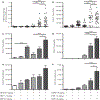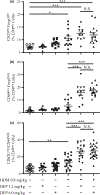Diesel exhaust particle exposure increases severity of allergic asthma in young mice
- PMID: 24112543
- PMCID: PMC11653749
- DOI: 10.1111/cea.12200
Diesel exhaust particle exposure increases severity of allergic asthma in young mice
Abstract
Background: Epidemiologic studies have reported an association between diesel exhaust particle (DEP) exposure, allergic sensitization, and childhood wheezing, although the mechanisms remain unclear. While DEP is known to augment allergic responses in adult animal models, its effects on sensitization and asthma severity in young animals is unknown.
Objective: To examine the impact of different doses of DEP and allergen co-exposure on allergic sensitization and asthma characteristics in young mice, and whether Th17 as well as Th2 responses are induced.
Methods: Lungs of 3-week-old wild-type Balb/c mice were exposed by pharyngeal aspiration nine times over 3 weeks to DEP at 1.2 or 6.0 mg/kg body weight, house dust mite (HDM) at 0.8, 1.2 or 6.0 mg/kg of DEP in combination with HDM, or the same volume (50 μL) of 0.9% sterile saline.
Results: In young mice, exposure to 1.2 mg/kg of DEP caused no detectable lung inflammation, but 6.0 mg/kg of DEP induced neutrophilic influx. Compared to HDM or DEP alone, mice exposed to either dose of DEP together with HDM demonstrated increased allergen-specific IgE, lung inflammation, airway hyperreactivity, goblet cell metaplasia, Th2/Th17 cytokines, dendritic cells, activated T cells, effector T cells, and IL-17(pos) and IL-13(pos) /IL-17A(pos) T effector cells.
Conclusions and clinical relevance: In young mice, co-exposure to DEP and HDM together exacerbated allergic sensitization and induced key characteristics of more severe asthma, including IL-17A, IL-17(pos) and IL-13(pos) /IL-17A(pos) T effector cells. While exposure to 1.2 mg/kg DEP alone caused no detectable changes, it did exacerbate allergic sensitization and asthma characteristics to a similar degree as a five-fold higher dose of DEP. This study demonstrates that exposure to DEP, even at a dose that alone causes no inflammation, exacerbates allergic asthma in young animals and suggests the importance of preventive measures to reduce the exposure of children to traffic related air pollution.
Keywords: T cells; Th17; Th2; air pollution; allergen; asthma; atopy; dendritic cells; diesel exhaust particle; house dust mite.
© 2013 John Wiley & Sons Ltd.
Conflict of interest statement
Conflict of interest
The authors declare no conflict of interest.
Figures








References
-
- Holgate ST. Innate and adaptive immune responses in asthma. Nat Med 2012; 18:673–83. - PubMed
-
- Simpson JL, Scott R, Boyle MJ, Gibson PG. Inflammatory subtypes in asthma: assessment and identification using induced sputum. Respirology 2006; 11:54–61. - PubMed
-
- Al-Ramli W, Préfontaine D, Chouiali F, Martin JG, Olivenstein R, Lemière C et al. T(H)17-associated cytokines (IL-17A and IL-17F) in severe asthma. J Allergy Clin Immunol 2009; 123:1185–7. - PubMed
Publication types
MeSH terms
Substances
Grants and funding
LinkOut - more resources
Full Text Sources
Other Literature Sources
Medical

